Why this resume works
- Quantifies accomplishments: By pulling metrics like a 25% increase in client base, the applicant’s accomplishments show clear impact and strategic growth.
- Highlights industry-specific skills: Skills such as “freight brokerage” and “shipment coordination” reveal the applicant’s deep understanding of logistics, ensuring they fit seamlessly into roles within this sector.
- Uses action-oriented language: Using action verbs like “negotiated” and “streamlined,” the applicant vividly captures their proactive approach and efficiency.
More Logistics Freight Broker Resume Examples
Review these logistics freight broker resume examples to see how to showcase your negotiation skills, industry knowledge, and relationship-building expertise. Use these samples to help you craft a resume that stands out in logistics roles.
Entry-level logistics freight broker
Why this resume works
- Effective use of keywords: By weaving in industry keywords like “logistics management” and “freight brokerage,” the applicant ensures their resume is ATS-friendly.
- Sections are well-organized: Effective use of bullet points and headers makes the resume easy to scan, ensuring key achievements are quickly accessible and improving readability.
- Centers on academic background: Advanced degrees in logistics and supply chain management effectively spotlight the applicant’s strong educational foundation early in their career.
Mid-level logistics freight broker
Why this resume works
- Points to measurable outcomes: By optimizing routes and negotiating significant contracts, the applicant illustrates their capability to drive measurable business outcomes like reducing costs by 15% and boosting client satisfaction.
- Demonstrates language abilities: The applicant’s language skills in Spanish, French, and German improve their ability to navigate international logistics challenges effectively.
- Displays technical expertise: Holding certifications such as Certified Logistics Professional showcases the applicant’s technical expertise important for roles requiring advanced knowledge in freight management and supply chain analytics.
Experienced logistics freight broker
Why this resume works
- Focuses on work history: Using a chronological resume format, the applicant’s extensive career experience in logistics is clearly outlined, making it easy to trace their professional growth and achievements.
- Emphasizes leadership skills: The applicant’s leadership skills shine through roles like freight operations manager, where they led a team to achieve 100% delivery accuracy.
- Lists relevant certifications: Listing certifications such as Certified Logistics Professional and Freight Broker Certification reinforce the applicant’s commitment to advancing their logistics expertise.
Logistics Freight Broker Resume Template (Text Version)
Yuki Smith
Detroit, MI 48210
(555)555-5555
Yuki.Smith@example.com
Professional Summary
Experienced logistics freight broker with proven track record in shipment coordination and cost reduction. Expertise in negotiating rates and improving delivery times. Skilled in client relationship management and carrier network expansion.
Work History
Logistics Freight Broker
Horizon Logistics – Detroit, MI
January 2023 – August 2025
- Increased client base by 25% in 6 months.
- Negotiated freight rates, saving 10% on costs.
- Coordinated logistics for over 200 shipments monthly.
Freight Coordinator
Summit Freight Lines – Detroit, MI
January 2021 – December 2022
- Managed 150+ shipments per month.
- Improved delivery times by 20%.
- Reduced shipping errors by 15%.
Logistics Specialist
BlueLine Transport – Detroit, MI
January 2019 – December 2020
- Streamlined logistics processes lowering costs by 12%
- Partnered with new carriers expanding network by 30%
- Increased shipment accuracy by 18%
Skills
- Freight Brokerage
- Logistics Management
- Rate Negotiation
- Client Relationship Management
- Shipment Coordination
- Cost Reduction
- Delivery Optimization
- Carrier Network Expansion
Education
January 2019
Texas A&M University College Station, Texas
Certifications
- Certified Transportation Broker – Transportation Intermediaries Association
- Logistics and Supply Chain Certification – APICS
Languages
- Spanish – Beginner (A1)
- French – Beginner (A1)
- German – Beginner (A1)
Related Resume Guides
Advice for Writing Your Logistics Freight Broker Resume
Looking to land a job as a logistics freight broker? You’re in the right place! Crafting a standout resume can make all the difference in showcasing your skills and experience in this fast-paced industry.
Dive into our tailored tips specifically for logistics professionals, and discover how to highlight your expertise in coordination, negotiation, and customer service.
Highlight your most relevant skills
When applying for the role of a logistics freight broker, listing relevant skills is key. Employers look for specific abilities that show you can handle the job’s demands. A well-organized skills section gives them a quick view of what you bring to the table.
It’s important to balance technical skills like knowledge of transportation management systems with interpersonal skills such as negotiation and communication. This mix shows you’re not only good at handling logistics tasks but also effective in dealing with clients and partners.
A strong approach is to weave these skills into your work experience section too. For example, instead of just saying “managed shipments,” you could say “used negotiation skills to reduce shipping costs by 10%.”
This way, your resume doesn’t just list your skills—it proves them with real-world examples. By doing this, your resume becomes more than just a list; it tells a story of how you’ve used your abilities in past roles. This method helps employers see you as an experienced logistics freight broker ready to make an impact.
Select a resume format that highlights your expertise in audits, budgets, and compliance.
Showcase your accomplishments
When organizing your work experience, list jobs in reverse-chronological order. Start with your most recent position and work backward. For each job entry, include your job title, employer name, location, and employment dates. This helps hiring managers see your current skills and experiences first.
As a logistics freight broker, it’s essential to highlight accomplishments rather than just tasks. Turn duties into achievements by showing measurable results: time saved, costs cut, or customer satisfaction improved. Instead of saying “managed shipments,” try “increased shipment efficiency by 20% through optimized routing.”
Quantifying achievements makes your resume stand out. Numbers like percentages or cost savings give clear evidence of your success. If you reduced shipping costs by a certain percentage or saved hours weekly with new procedures, be sure to mention those figures.
Use action-oriented language to show direct impact on the company’s performance. Words like “negotiated,” “implemented,” and “streamlined” are powerful for showcasing accomplishments as a logistics freight broker.
Quantifying your achievements lets hiring managers quickly assess how you can benefit their team with proven results from past roles, so don’t skip this step.
5 logistics freight broker work history bullet point examples
- Negotiated freight rates with carriers, achieving a 15% reduction in transportation costs over 12 months.
- Built and maintained relationships with 50+ carriers, ensuring consistent capacity for client shipments.
- Streamlined shipment tracking processes, improving on-time delivery rates by 20%.
- Secured contracts with new clients, increasing monthly revenue by $50,000.
- Analyzed market trends to identify cost-saving opportunities, leading to a 10% increase in profit margins.
Choose a resume template featuring clear sections, simple fonts, and ample white space for readability. Avoid bright colors or elaborate designs to highlight your skills and work history effectively.
Write a strong professional summary
A professional summary on a resume serves as an introduction to hiring managers, giving them a quick overview of who you are and what you bring to the table. Choose between a summary or an objective depending on your career stage and goals.
A professional summary is a brief paragraph (three to four sentences) that highlights your experience, skills, and achievements. It’s best for experienced applicants who want to showcase their professional identity and value quickly. For a logistics freight broker, this might include years in the industry, key skills like negotiation and customer service, and significant accomplishments like increasing route efficiency.
Resume objectives are statements of your career goals. They work well for entry-level job seekers, career changers, or those with employment gaps. While summaries focus on “what I’ve accomplished,” objectives highlight “what I aim to contribute.”
Next, let’s go through examples of both summaries and objectives tailored for different experience levels.
Logistics freight broker resume summary examples
Entry-level
Recent graduate with a Bachelor of Science in Logistics and Supply Chain Management, eager to begin a career as a logistics freight broker. Possesses foundational knowledge in transportation management, freight negotiation, and customer service. Completed an internship at ABC Logistics where skills in coordinating shipments and managing documentation were applied. Certified in Freight Broker/Agent Training and passionate about optimizing the shipping process.
Mid-career
Results-driven logistics freight broker with seven years of experience in managing domestic and international freight operations. Proven track record of building strong relationships with carriers and clients while negotiating competitive rates. Successfully managed high-volume accounts at XYZ Transport, leading to a 15% increase in annual revenue. Known for excellent problem-solving skills and the ability to streamline processes to ensure timely delivery.
Experienced
Seasoned logistics freight broker with over 15 years of expertise in strategic planning and operational leadership within the transportation industry. Expert in guiding teams through complex negotiations, developing key partnerships, and implementing cost-effective solutions that drive business growth. As senior broker at DEF Freight Services, led initiatives that reduced transit times by 20% across major lanes. Committed to fostering innovation and excellence within the logistics space.
Logistics freight broker resume objective examples
Recent graduate
Ambitious and dedicated recent logistics and supply chain management graduate seeking an entry-level logistics freight broker position to use academic knowledge and analytical skills in coordinating efficient transportation of goods. Eager to contribute to optimizing supply chain operations and ensuring timely deliveries.
Career changer
Passionate professional transitioning into logistics freight brokering, with a solid background in customer service and sales. Seeking an opportunity to apply interpersonal skills and problem-solving abilities in managing freight logistics and building strong client relationships within the transportation industry.
Specialized training
Detail-oriented individual with specialized training in transportation logistics aiming for a role as a logistics freight broker. Focused on leveraging knowledge of routing software and carrier negotiations to facilitate smooth freight movement and improve operational efficiency.
Make your logistics freight broker resume quickly with our Resume Builder. Just choose a template, fill in your info, and get content suggestions for your job title to create a professional-looking resume in minutes!
Match your resume to the job description
Tailoring your resume to job descriptions is key to standing out. Employers use applicant tracking systems (ATS) that scan resumes for specific keywords and phrases. By aligning your resume with these keywords, you increase your chances of getting noticed and advancing in the hiring process.
An ATS-friendly resume incorporates keywords from the job posting that align with your skills and experiences. Including these terms makes it more likely for a hiring manager to notice your application, ensuring it gets through initial screenings.
To find the right keywords, read the job posting carefully for repeated skills, qualifications, and duties. For instance, if a logistics freight broker position frequently mentions “client communication,” “negotiation skills,” or “supply chain management,” these are important terms to include in your resume.
Incorporate these terms naturally by rewriting parts of your work history. If a job duty was “managed client relationships,” you could phrase it as “handled client communication and maintained strong relationships.” This effectively uses language from the job description to show your impact.
A targeted resume not only improves ATS compatibility but also shows employers that you understand their needs. When you customize your resume to align your skills with their requirements, you demonstrate readiness for the role and increase your chances of securing an interview.
Don’t let ATS software reject your resume! Our ATS Resume Checker makes sure your resume is formatted right and has the best keywords.
FAQ
Do I need to include a cover letter with my logistics freight broker resume?
Yes, including a cover letter with your logistics freight broker resume can improve your application by demonstrating your unique qualifications and interest in the role.
A cover letter provides an opportunity to highlight your specific skills in negotiations, relationship management, and logistics coordination that make you an ideal job seeker.
For example, you might reference successful projects or partnerships you’ve managed that align with the company’s needs or emphasize your ability to solve complex logistical challenges efficiently.
To assist you in crafting a compelling cover letter, consider using our Cover Letter Generator.
This tool can streamline the process by offering tailored content suggestions based on your resume details.
Additionally, reviewing cover letter examples specific to logistics roles can offer valuable insights into how to effectively structure and customize your message for maximum impact.
How long should a logistics freight broker resume be?
For a logistics freight broker, a one-page resume is ideal for highlighting core competencies like negotiation skills, industry knowledge, and familiarity with logistics software. This format ensures that your most relevant experiences and skills stand out effectively.
If you have extensive experience or numerous certifications directly related to logistics and freight brokerage, a two-page resume might be more appropriate. This approach allows you to delve deeper into specific accomplishments and showcase a broader range of expertise without overcrowding the page.
Ultimately, understanding how long a resume should be can help you determine the best approach for you based on your career stage and achievements in the field.
How do you write a logistics freight broker resume with no experience?
When writing a logistics freight broker resume with no experience, focus on highlighting your relevant skills, education, and any related training to showcase your potential in the industry.
- Emphasize transferable skills: Highlight skills such as communication, negotiation, customer service, and problem-solving. These are important for a freight broker role and can be gained from various experiences outside of direct logistics work.
- Detail relevant coursework or certifications: List any logistics-related courses or certifications you’ve completed. This could include supply chain management classes or online courses about freight brokerage.
- Include volunteer experiences or internships: If you’ve volunteered or interned in roles related to sales, transportation, or logistics planning, detail these experiences to show your proactive approach toward gaining industry knowledge.
Check out our detailed guide on crafting a resume with no experience for more examples and expert tips tailored by Certified Professional Resume Writers.
Rate this article
Logistics Freight Broker
Additional Resources
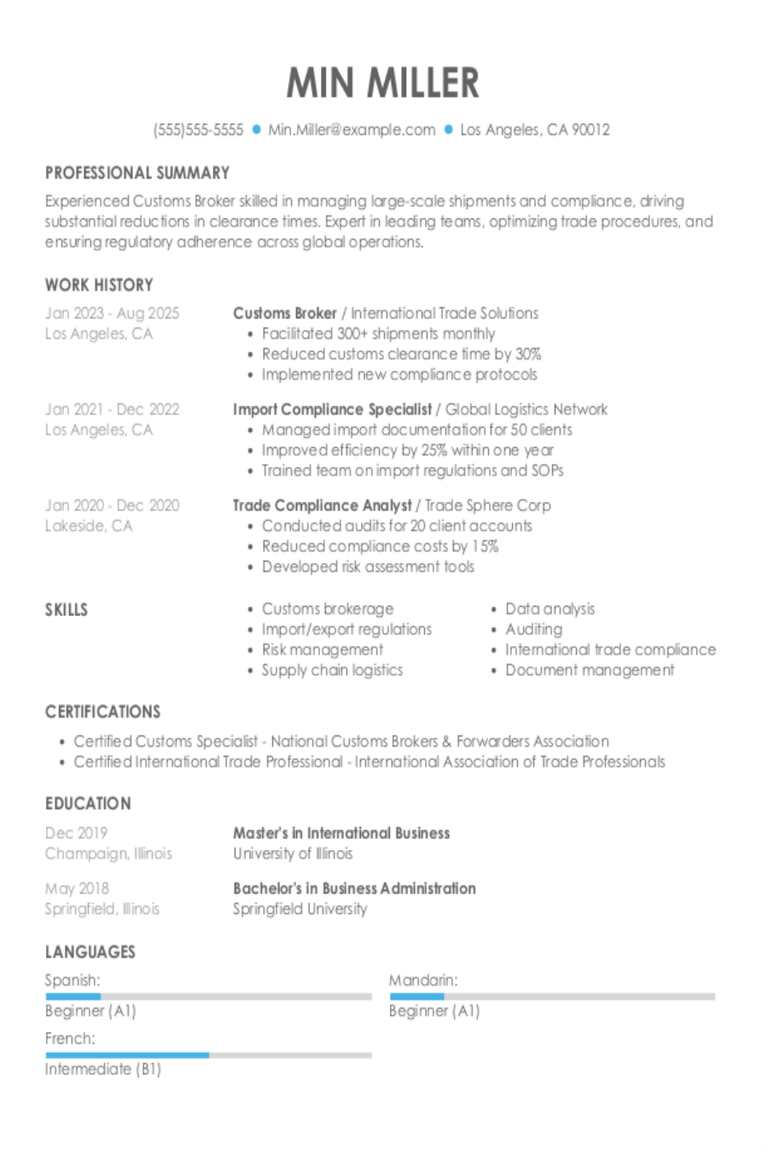
Customs Broker Resume Examples & Templates for 2025
Discover customs broker resume examples and tips that will help you write about your organizational skills and experience handling shipments across borders.Build my resumeImport existing resumeCustomize this templateWhy this resume
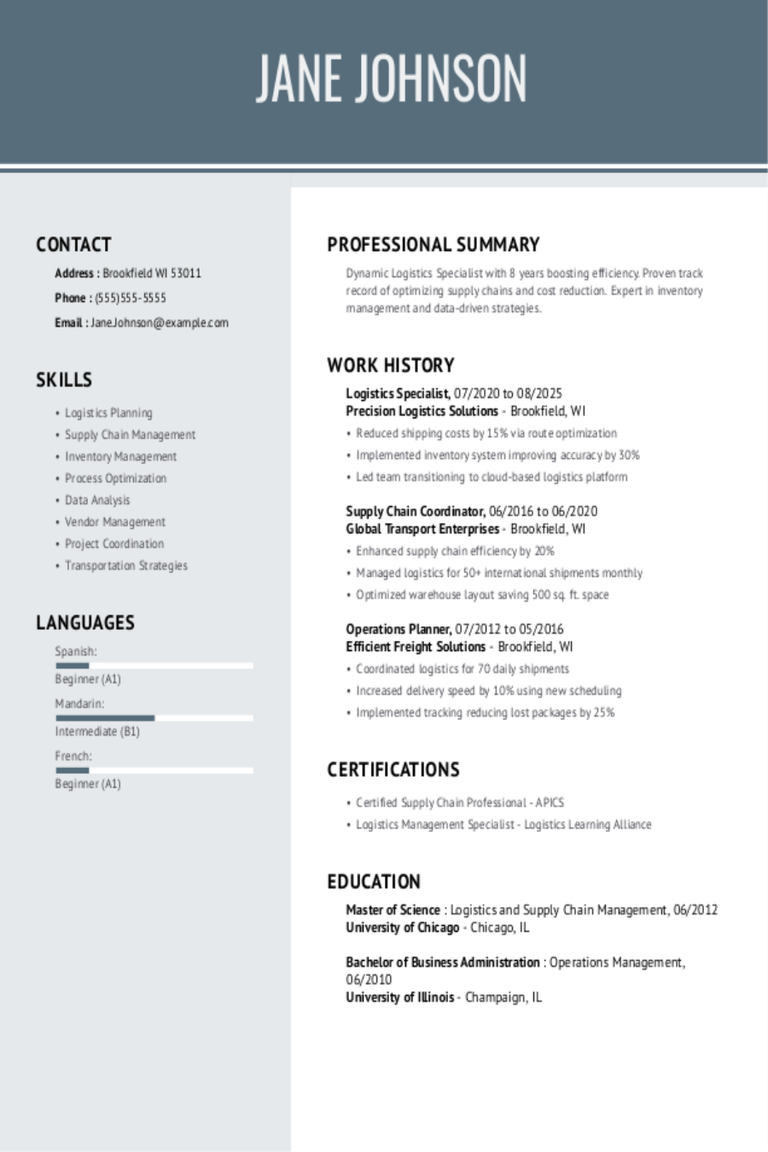
Logistics Specialist Resume Examples & Templates for 2025
As a logistics specialist, your resume should show how you plan shipments, manage inventory, and solve problems. Use our examples to help you highlight organization and teamwork without sounding too
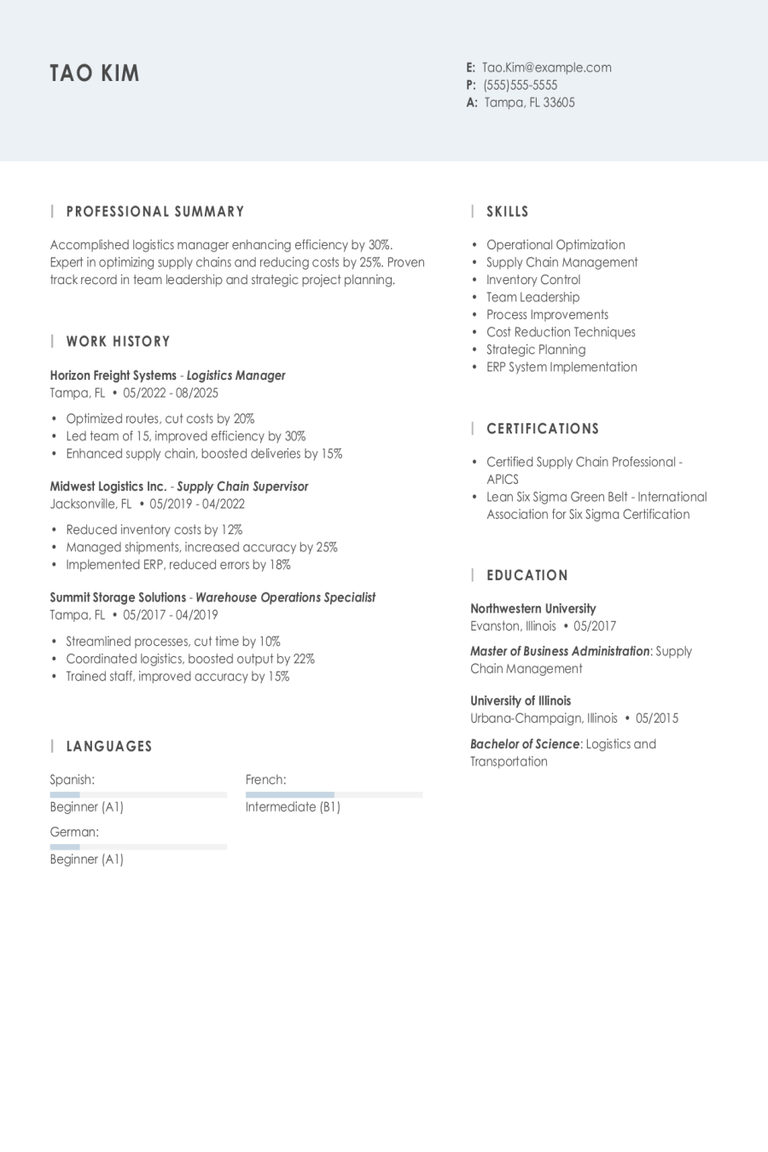
Logistics Manager Resume Examples & Templates for 2025
As a logistics manager, your resume needs to highlight more than just moving goods. Learn to showcase your skills in planning, problem-solving, and keeping operations smooth and efficient.Build my resumeImport
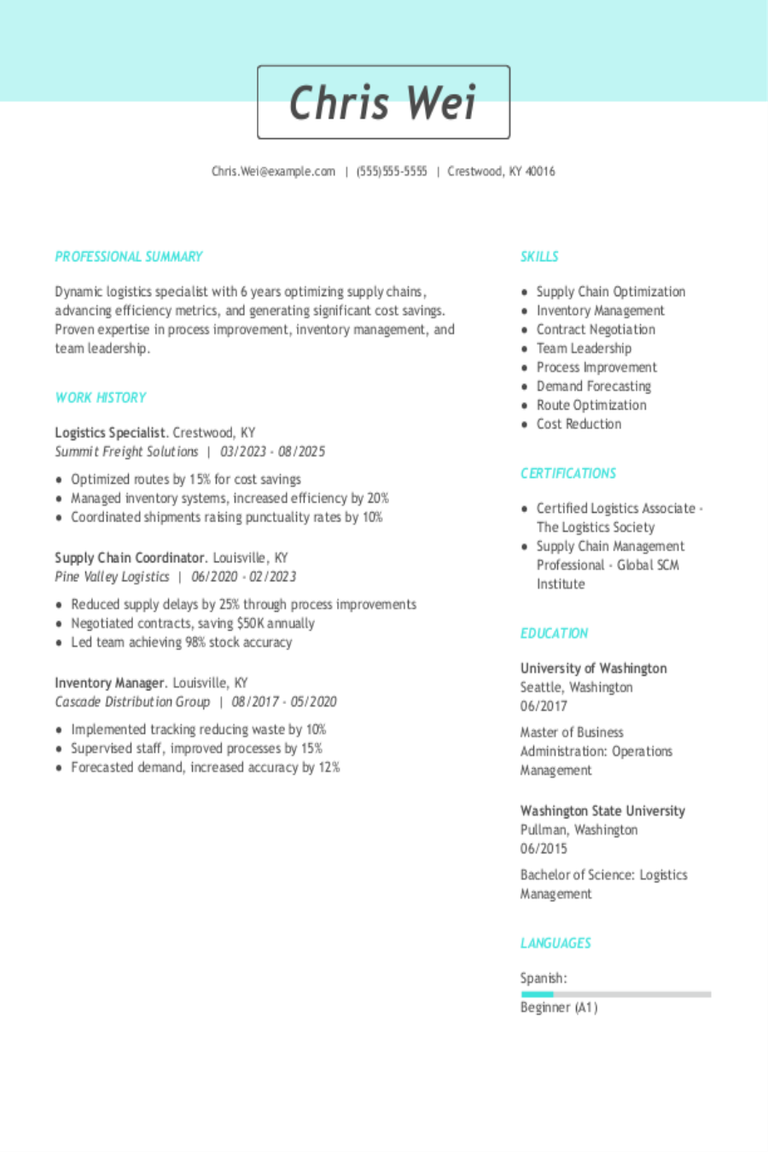
Logistics Resume Examples & Templates for 2025
Learn how logistics experts showcase their ability to organize shipments, manage inventory, and solve delivery problems. These resume examples and tips will help you write a resume that highlights your
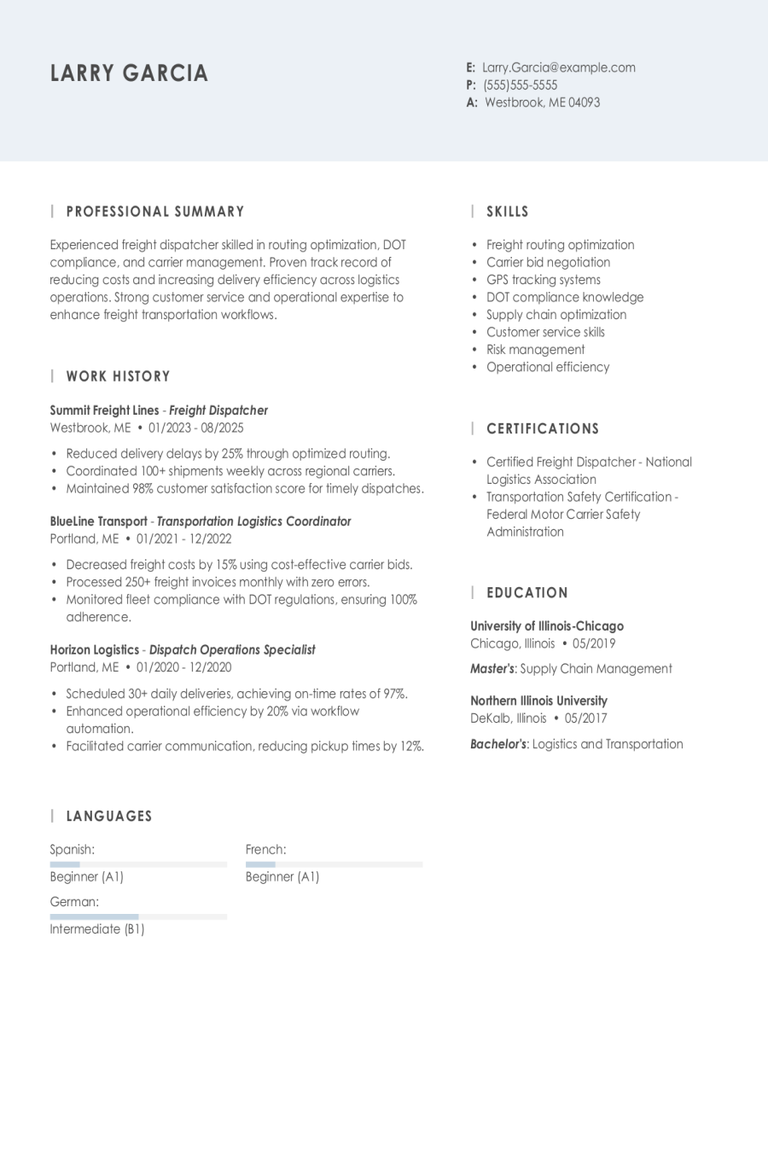
Freight Dispatcher Resume Examples & Templates for 2025
Discover freight dispatcher resume examples that emphasize communication, problem-solving, and time management skills. Learn how to showcase your ability to coordinate shipments efficiently and keep operations running smoothly.Build my resumeImport
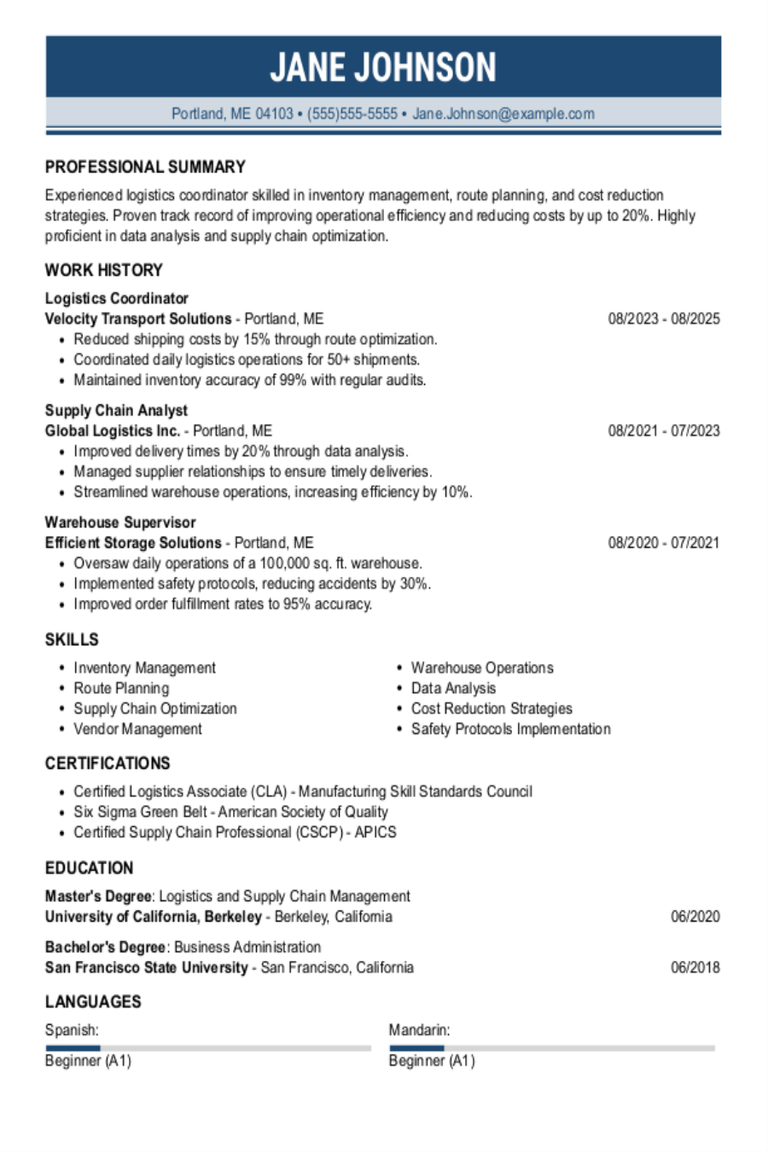
Logistics Coordinator Resume Examples & Templates for 2025
As a logistics coordinator, your resume must show how you keep shipments on track, handle inventory smoothly, and work well with teams. Use this guide to learn how to showcase
